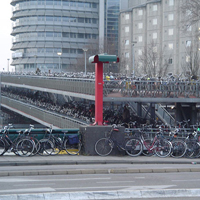Planning of mobility and parking. The acting of the Urban Mobility Plan
Abstract
In the urban areas the mobility system is strategic for its working and it is composed of a series of territorial closely interrelated elements. Among these the parking is one of the most important and its organization is a key point of an appropriate planning of mobility: this importance is mainly due to its character of attractor of vehicular flows. The structure of large and medium sized Italian cities imposes many constraints to the creation and the use of parking areas for their impact on the urban livability; the problem is the organization of the whole city, the correct location of the areas and the opportunity to regulate the access to certain areas: in fact the programming of parking areas can have strong repercussions on the city. Another element can be considered: the choice to build parking areas in the center of the towns is in logical conflict with the traffic limiting policies, because the infrastructure, if built, can be used and the investment must be repaid; on the other hand, the decision that some sensitive areas should not be affected by parking infrastructure produces the necessity to strengthen other public services: the question is not only physical (space availability), but it is related with the distribution of opportunities and equipments, so if the center is better served by public transport, the periphery must be served by other infrastructures. As said, the choice of sites for parking’s location and the determination of their operating characteristics can have strong impacts on the organization and the livability of the city itself; it follows the necessity of a close connection with the urban planning and an attention to the morphological characters of the different parts of the city. The tools for planning the mobility and, within it, the parking system, are several. The Urban Mobility Plan is the newest among them; it is a strategic tool because its effects are gathered on the system as a whole and it assumes an overall rationalization and development of networks and vehicles. The paper deepens the characters of this tool, starting from the legislative forecasts, and thereafter on the basis of case-studies. The first part analyses the notions connected with the urban structure, the mobility and the parking system. In the second step the prescriptive aspects are analyzed: the Urban Mobility Plan and the Urban Parking Program are deepen in relation with their main aspects and in relation whit the parking problems. The third part analyses two case-studies; the cases highlights the different application philosophy, in particular for the connection between urban areas and parking system. At least, in the fourth part, are analyzed techniques and tools for solving the parking’ problem, the different modalities for its organization and the management techniques aimed at encouraging more correct behaviors in relation to the different urban areas.Downloads

Copyright (c) 2014 Tema. Journal of Land Use, Mobility and Environment

This work is licensed under a Creative Commons Attribution 4.0 International License.
Authors who publish in this journal agree to the following:
1. Authors retain the rights to their work and give in to the journal the right of first publication of the work simultaneously licensed under a Creative Commons License - Attribution that allows others to share the work indicating the authorship and the initial publication in this journal.
2. Authors can adhere to other agreements of non-exclusive license for the distribution of the published version of the work (ex. To deposit it in an institutional repository or to publish it in a monography), provided to indicate that the document was first published in this journal.
3. Authors can distribute their work online (ex. In institutional repositories or in their website) prior to and during the submission process, as it can lead to productive exchanges and it can increase the quotations of the published work (See The Effect of Open Access)
